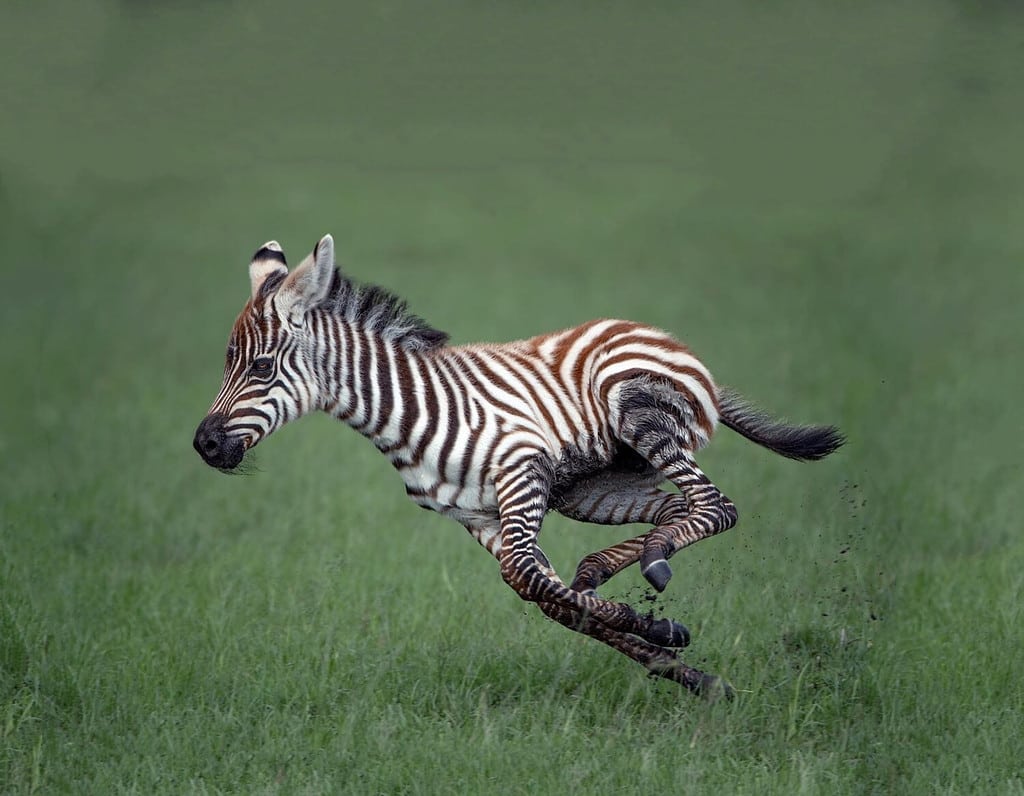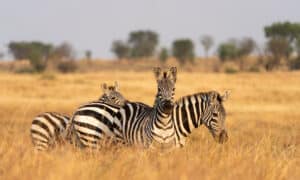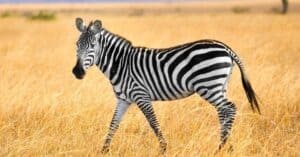Zebras, with their horse-like bodies and distinctive black and white stripes, are among the most recognizable animals in the world. Within their natural habitat, though, these stripes do not seem to do much to camouflage them or make them stand out. Zebras tend to rely on other factors, such as their speed, to avoid predators. How fast are zebras? On average, zebras run about 40 miles per hour. Many of their natural predators can outrun them easily over short distances. So how, then, do these animals survive? Let’s learn more about the top speeds of zebras, how they compare to several of their predators and more.
How Fast Can Different Zebras Run?

On average, most zebras have a top speed of about 40 miles per hour.
©MattiaATH/Shutterstock.com
Three different zebra species exist in the wild today, including the Grévy’s zebra (Equus grevyi), the plains zebra (Equus quagga), and the mountain zebra (Equus zebra). The different species vary somewhat in size, as well as speed.
Grévy’s Zebra
Grévy’s zebra is both the largest and the rarest of the zebra species. The IUCN Red List of Threatened Species lists the Grévy’s zebra as Endangered with fewer than 2,000 mature individuals remaining. This species ranges over small portions of Kenya and Ethiopia. Grévy’s zebras reach lengths of 8.2 to 9 feet, and they weigh up to 990 pounds. The Grévy’s zebra can run at speeds from about 40 to 43 miles per hour.
Plains Zebra
The plains zebra is smaller than the Grévy’s zebra. The IUCN Red List categorizes this species as near threatened with a population between 150,000 and 200,000. This species ranges over portions of several countries in eastern and southern Africa, living mostly on the plains and savannas. Plains zebras reach lengths of between 7.1 to 8.1 feet and weigh up to 710 pounds. This species averages about 40 miles per hour.
Mountain Zebra
The mountain zebra is reportedly slightly slower than the other species, reaching speeds of 35 to 40 miles per hour. Mountain zebras, unlike the other species which live mainly in the grasslands, occupy primarily mountainous regions. The Hartmann’s mountain zebra subspecies live in mountainous western Namibia with some small populations in Angola and South Africa, while the Cape mountain zebra subspecies live in scattered populations in South Africa. The IUCN Red List categorizes the mountain zebra as Vulnerable with fewer than 35,000 mature individuals remaining. Mountain zebras reach lengths of nearly 7 feet to 8.5 feet and weigh up to 820 pounds.
How Fast Are Baby Zebras?

Baby zebras can run fast, but not as fast as their parents or most predators.
©Vladimir Turkenich/Shutterstock.com
Baby zebras are precocial animals. They can walk within 20 minutes after they are born. They can run within an hour. However, baby zebras cannot run as fast as their parents, because they have significantly shorter legs. They depend on the protection of the herd to keep them from being eaten by predators.
Greatest Threats to Zebras

Not even the powerful kick of a zebra can defeat their greatest threats.
©Joe McDonald/Shutterstock.com
All three zebra species face significant threats and require conservation measures to survive. Habitat degradation and fragmentation pose significant threats. Hunting for hides, meat, and traditional medicine has caused the greatest decline in zebra populations over time. Even with conservation efforts and education, people continue to hunt zebras, sometimes at a higher rate than they can reproduce. Predators also threaten zebras. These large mammals face a number of predators in the wild, many of which can run faster than they can.
How Fast Are Zebras Compared to Predators?

Zebras may not be as fast as some of their predators, but they can outrun them over long distances.
©GUDKOV ANDREY/Shutterstock.com
Some of the common predators of zebras include lions, cheetahs, leopards, hyenas, wild dogs, and crocodiles. Zebras use a combination of speed and agility to evade predators. They often run in zigzags, making swift turns. They can also use powerful kicks to fight off predators that get too close.
Some predators use stealth to sneak up on zebras before they can sprint away. Others hunt in packs to increase their chances of a kill. Young, old, or injured individuals have the highest risk of becoming prey.
Healthy adult zebras can run at their top speed of around 40 miles per hour for more than a mile. And they can run nearly the equivalent of a half marathon maintaining speeds of around 30 miles per hour. Predators must generally make their kill quickly or face being left behind by these powerful animals.
A Comparison of Zebras and Their Predators
The table below lists the speeds of zebras as compared to several of their predators.
| Animal | Average Top Speed |
|---|---|
| Zebra | 40 miles per hour |
| Lion | 46 miles per hour |
| Cheetah | 75 miles per hour |
| Leopard | 36 miles per hour |
| Hyena | 40 miles per hour |
| African Wild Dog | 44 miles per hour |
| Nile Crocodile | 22 miles per hour |
The photo featured at the top of this post is © fidanci/iStock via Getty Images
Thank you for reading! Have some feedback for us? Contact the AZ Animals editorial team.







